|
links about
– tsunami –
DigitalGlobe is making more high-resolution satellite images available to media for free; this set is from the Banda Aceh shore in Indonesia:
Tsunami Satellite Photos
A study of the danger to coastal settlements in Australia from the threat of tsunami is available at:
The Tsunami Papers
Other interesting links for more information about tsunami are listed below:
Tsunami from Asteroid/Comet Impacts
Science of Tsunami
Hazards
Two Decades of Global Tsunamis
1982 – 2002
Simulation of
Impact Tsunami
Washington University
Tsunami page
Pacific Tsunami Museum, Hawaii
Asteroid Tsunami
National Oceanic
& Atmospheric Administation
Tsunami page
A Selection of Books About:
Tsunami
Tidal Waves
Earthquakes
Volcanoes

“Tsunamis in the
Mediterranean Sea
2000 BC-2000AD”
Sergei Leonidovich
Solovev (Editor)
Olga N. Solovieva
Chan N. Go
Khen S. Kim
Nikolay A. Shchetnikov
Sergey L. Soloviev

EU English Edition
“The founder and recognized leader of the Russian scientific school of tsunami researchers Sergey (1930-94) and his collaborators describe in detail the waves generated by earthquakes and accompanying phenomena in a region prone to earthquakes and where the written record allows a study of four millennia. Most of the material is quantitative information, including coordinates of the observation sites, dates, heights of tsunami run-ups, main parameters of the earthquakes, and tide gauge records. That is augmented by the electronic database created in the Tsumani Laboratory, Institute of Computational Mathematics and Mathematical Geophysics in Novosibirsk. Only geographical names are indexed.
“Tsunami: Monster Waves (American Disasters)”
Mary Dodson Wade
Janet Hamilton

EU English Edition
“Grade 4-7-Tsunamis, although not common, hold a fascination for both shore dwellers and inland inhabitants. The idea of a huge wave coming suddenly with little warning and capable of major devastation is both awesome and horrifying. This pedestrian book capitalizes on the destructive nature of these great waves.”
“Tidal Waves Wash Away Cities”
Kate Petty
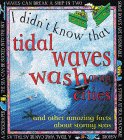
EU English Edition
“Kids in grades 1-3 will enjoy this set of simple yet entertaining facts about tidal waves: from underwater volcanic action to tidal action and ocean problems, this packs in details about tidal waves and their effects on human habitation with over 30 pages including a glossary and bright photos set against black pages.”
“Landslides and Tsunamis”
Barbara Keating, Christopher Waythomas &
Alastair Dawson
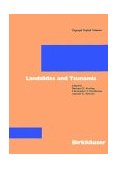
EU English Edition
“The study of tsunamis has been shifting away from theoretical modeling of tsunami source, wave propagation and runup toward multidisciplinary investigations, with an emphasis on field studies. This collection of papers highlights the many approaches being utilized to study landslides and tsunamis.”
“Caribbean Tsunamis:
A 500-year History from 1498 – 1998″
Karen Fay O`Loughlin, James F. Lander (Editor)

EU English Edition
“In the past 500 years, the Caribbean region has had devastating tsunamis causing incalculable damage. It is an area of relatively high seismicity, and although tsunamis are not the chief natural hazard, they have the potential to produce catastrophic regional disasters.
“Today the necessity for awareness is of paramount importance. Tectonic forces continually build stress – until the inevitable release of strain that may trigger a tsunamigenic earthquake. The lack of a major tsunami in the past 57 years is due to a relative lack of relief of built-up energy, and the potential extent of the stress release grows as time elapses. The long period without relief of seismic stress buildup only increases the ominous threat of a devastating tsunami that could result from a sudden seafloor cataclysm.
|
|
The links below are to pages that will give you more information on tsunami – the giant tidal waves that can be caused by undersea earthquakes, volcanoes, landslides, and, as it has recently been realised, by the impacts of asteroids, comets and meteorites in the oceans. Their incredible destructive power has been responsible for the sweeping away of many coastal towns, villages, and inundating huge landmasses throughout history and prehistory.
Following tsunami there is often very little evidence left for future archæologists to discover, and it is highly probable that much of the evidence of civilisation near coastal areas in prehistoric times has simply been wiped away by these incredible forces of nature.
One recent study has discovered that, according to radiocarbon dating of sediments from the area, a ‘giant tsunami’ hit the eastern coast of Scotland in 5,800 BC. Stone tools found in the sand off Inverness showed that the waves hit the area without warning following a landslide off Storegga in north-west Norway.
Professor Smith, of the Department of Geography at Coventry University, told
BBC News Online:
“It looks as if those people were happily sitting in their camp when this wave from the sea hit the camp. Professor Smith of the department of Geography at Coventry University told BBC News Online. We’re talking about two, three or four large waves followed by little ones, that would have been 5-10 metres high. These waves do strike with such force that they are very destructive. It’s like being hit by an express train’.”
A little further south, on Moel Tryfan in North Wales, the mashed and mangled remains of marine molluscs (sea-shells) have been found in so-called ‘Ice-Age drift deposits’ supposedly left there when the ice-sheets melted and retreated back towards the North Pole. But the composition of the supposed ice-sheet deposits told another story.
In their book “Cataclysm: Compelling Evidence of a Cosmic Catastrophe in 9,500 BB”, an academic study of the evidence suggesting that the flood myths of ancient times were based on archaic memories of a ‘real global tsunami’, or ‘deluge’, and which challenges the orthodox interpretation of geological history descending from the notions of a Pleistocene Ice Age theorised by Louis Agassiz in the 1820s, authors D. S. Allan and J. B. state:
“Eroded and fragmentary shells occur within the ‘drift’ deposits on Moel Tryfaen, a mountain in North Wales rising 1,300ft (400m) above sea level. Perplexingly the species represented include not only northern but also temperate and southern forms adapted to very varied habitats. Some required deep and others shallow water, some sandy and others muddy water, and some were peculiar to shingly and others to a bare rocky environment.
In stating that ice could never have brought together so varied a molluscan assemblage as this, it is hardly necessary to add that water could have – in which case the enveloping drift’ deposits must have been similarly water-borne.”
In fact many of the ‘peculiarities’ conventionally attributed to an Ice Age simply could not have been created by the supposed advance and retreat of ice-sheets. Yet, if the many and various ‘flood-myths’ of antiquity, which have been passed down through millennia in the oral traditions of peoples worldwide, are based on true recollections of an ‘archaic deluge’, a catastrophic mega-tsunami could well have produced ALL of the phenomena now attributed to an Ice Age.
These would include:
-
the global distribution of ‘erratic boulders’ – especially in the latitudes which even the die-hard glaciologists admit were not covered with ice-sheets …
-
the multi-zone distribution of flora, fauna and marine life-forms in the composition of so-called ‘glacial drift’ in areas where no ice-sheets are even claimed to have existed …
-
and also in the pitiful conglomerations of broken and twisted remains of animals, birds, fish, trees and plants, pebbles, dirts and clays which can be found in caves and rock crevices in many areas around the world – not to mention the remains of whales and other sea creatures found on mountaintops – irrespective of theorised Pleistocene ice-sheet coverage …
NONE of these supposed ‘Ice Age Peculiarities’ could have been achieved solely by the action of Ice moving horizontally across hilly terrains. The nature of Ice is such that it cannot move uphill, and, as recent scientific surveys have concluded that there were never any huge mountains at the North Pole for ice-sheets to have slid down, ONLY the turbulent waters of mega-tsunami could have brought together such jumbles of life-forms, and forcibly jammed them into the small, tight places we find them today …
Was there really an Ice Age?
Or are the Deluge Traditions and Flood Myths of antiquity based on a sounder ancient science:
Tsunami
One of the best resources for understanding the
December 2004 Tsunami tragedy is the
Sydney Morning Herald’s
Interactive Tsunami Map
Official Tsunami Monitoring Centres :
International Tsunami Information Centre
Yuzhno-Sakhalinsk Tsunami Warning Center
National Geophysical Data Center – Tsunami Database
NOAA Tsunami Research Center
FEMA Fact Sheet: Tsunami
West Coast & Alaska Tsunami Warning Center
–
Latest Tsunami Bulletin
–
Pacific Tsunami Warning Center
–
Latest Tsunami Bulletin
–
Recorded Recent Tsunami
Below are a selection of recent stories from our
News Headlines Archive
Below those are newer 2008 stories in latest date order
…
“The great flood of 1607”
January 30, 2007, BBC Bristol, England:
“Four hundred years ago, in the reign of James I of England, a disaster hit the south west of the country, as a huge surge of water coursed up the Bristol Channel – covering 200 square miles of land with water and killing 2,000 people.
|
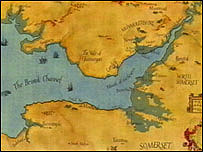
BBC Bristol
Blue shading shows flooded areas
|
|
Eyewitness accounts of the great flood of 30 January 1607 tell of ‘huge and mighty hills of water’ advancing at a speed ‘faster than a greyhound can run’ and only receding 10 days later.
The flood reached a speed of 30mph and a height of 25ft.
|
It swept up to four miles inland in the Bristol area, north Devon, Pembrokeshire, Glamorgan, Monmouthshire and Cardiff – and up to 14 miles inland in low-lying parts of Somerset. But it is still not certain exactly what sparked the disaster which killed so many.
For centuries it was thought high tides and severe storms were to blame, a theory accepted by Dr Kevin Horsburgh from the Proudman Oceanographic Laboratory in Liverpool, who said a massive storm surge, formed by a combination of high tides and hurricane winds, may have been to blame.
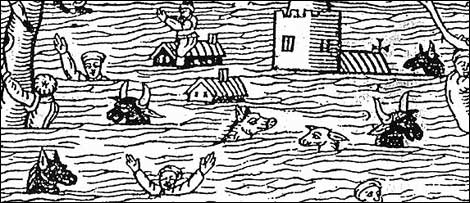
BBC Bristol
But a tsunami theory was put forward by experts from Bath and Australia in 2004, supported by evidence of deposits of sand, pebbles and shell at various locations around the Severn Estuary where flood waters swept in, including Hill in South Gloucestershire.
It’s believed these deposits may have been brought in from the open ocean.”
[Full Story]
“Anniversary of 1607 killer wave”
January 30, 2007, BBC News Online, UK:
“A suspected tsunami in the Bristol Channel which killed 2,000 people happened 400 years ago on Tuesday.
Experts believe severe flooding on 30 January 1607 in south west England and south Wales was caused by a tsunami – and not a storm surge or high tides. It is estimated 200 square miles (520 sq km) of land were covered by water.
Simon Hasslett from Bath Spa University said there was currently no tsunami warning system in place. He said the research was important for informing coastal and risk management plans.
The flood of 1607 has been described by experts as the worst natural disaster to hit Britain. Eyewitness accounts of the disaster told of ‘huge and mighty hills of water’ advancing at a speed ‘faster than a greyhound can run’.”
[Full Story]
Below are a selection of 2008 stories from our
News Headlines Archive
“Did asteroid cause ancient N.Y. tsunami?”
November 20, 2008, MSNBC News, USA
“Long before New York City was the Big Apple, or even New Amsterdam, a giant tsunami crashed ashore.
It was 2,300 years ago. The Palisades that frame the Hudson River were whisper-quiet, the sandy beaches of Long Island and New Jersey empty, and Manhattan was still just an unbroken sylvan carpet.
More than 2,300 years ago, a tsunami may have hit what is now New York City
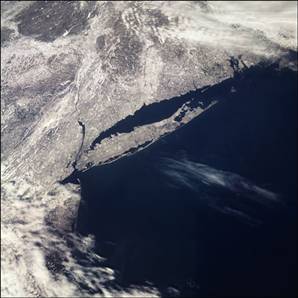
Getty Image/MSNBC News
Then came the mammoth wave, roaring into the serenity. No one knows for sure what caused it, but new clues found in the Hudson’s silt suggest an asteroid 100 meters (330 feet) in diameter slammed into the Atlantic Ocean nearby.
‘But the main thing that closes the deal is that we looked in the spherules and found nano-diamonds’, said Dallas Abbott of Columbia University, a co-author on the work. ‘These have only been found in impact ejecta or in meteorites.’
The team found grains of several shocked minerals in the sediments as well, but the discovery remains controversial.”
[Full Story]
“Devastating tsunami had a predecessor”
October 30, 2008, ABC Science News, Australia
“A full-sized forerunner to the 2004 Indian Ocean tsunami hit the region between 500 and 700 years ago, a new study suggests.
Two groups of geoscientists report evidence today in the journal “Nature” that a similar event occurred around 1400 AD.
Until now there has been no historical record of a predecessor to the Indian Ocean tsunami and the associated magnitude 9.2 associated earthquake.
Amy Prendergast from Geoscience Australia in Canberra, Australia and colleagues studied the sedimentary record on an island north of Phuket, Thailand to help pin point the date of ancient tsunamis.”
[Full Story]
“Tsunami in 2004 ‘not the first'”
October 29, 2008, BBC Science News, UK
“The Indian Ocean tsunami in 2004 was not the first of its size to hit the region, according to new research. Two international collaborations have sampled the sediments in Thailand and Sumatra to examine tsunami history.
Before and after photos show the sediment coverage after the 2004 tsunami
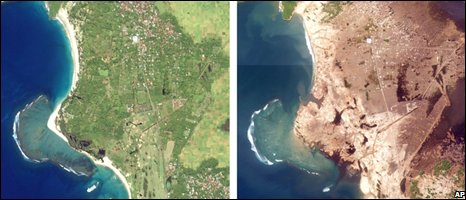
BBC Science News
At both sites, there was evidence of sediment laid down by a large tsunami between 600 and 700 years ago, pre-dating written and oral records.
The findings, reported in Nature, could be used to put statistical weight behind estimates of future tsunami.
The surge of a tsunami brings with it a great deal of sediment that rushes inland; the bigger the tsunami, the deeper and further inland the layer of sediment it leaves behind.
In locations where those deposits aren’t disturbed by wind or running water, they can be used as a historical record of these powerful events after more layers are added.
The study of these layers in coastal regions has revealed instances of tsunami elsewhere in the world, including a prehistoric event that inundated the Shetland and Orkney islands off Scotland.”
[Full Story]
“Tsunami might have wiped off prehistoric village
in Austrian Alps”
October 12, 2008, Thaindian News, Thailand
“A geologist has found evidence that a vast rock slide may have set off a tsunami that buried a prehistoric village on Lake Mondsee in the Austrian Alps.
According to a report in Spiegel Online [see article below. Ed.], the theory that a severe rockslide in the Alps destroyed a prehistoric village, has been put forward by Alexander Binsteiner, a geologist and flint stone expert.
He estimates that the fractured cliff consisted of ’50 million cubic meters’ of rock, and that an ensuing tsunami at least five meters (16 feet) tall rushed against the opposite shore, inundating the settlement there.”
[Full Story]
“An Alpine Pompeii from the Stone Age”
October 10, 2008, Spiegel Online, Germany
“What happened to the prehistoric village on Lake Mondsee in the Austrian Alps? One geologist has found evidence that a vast rock slide may have set off a tsunami that buried the lakeside settlement.
He’s hoping to find funding — and mummies. Could it be that a severe rockslide in the Alps destroyed a prehistoric village?
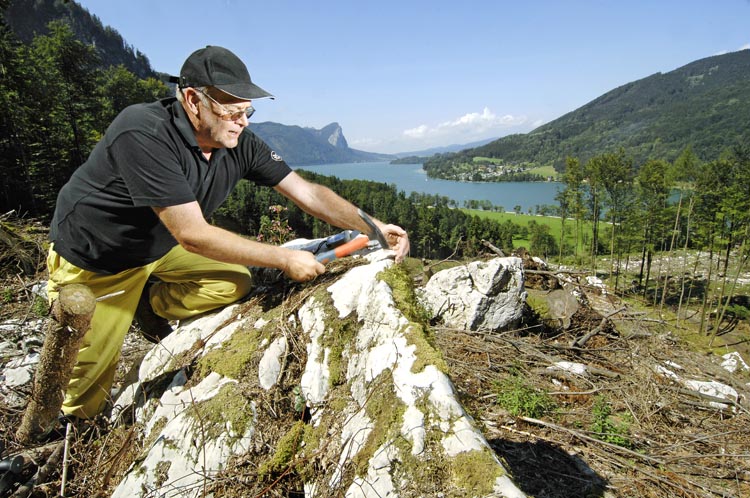
Wolfgang Maria Weber/Der Spiegel, Germany
Alexander Binsteiner, a geologist and flint stone expert, has proposed the thesis. He believes that the accident affected lake dwellers living on the eastern tip of Mondsee Lake, near present-day Salzburg. Twenty to 50 wooden huts, coated with mud or cow dung, stood there on stilts along the lakefront. The women wore dresses made of flax, decorated with shells and snails, and the men wore bast fiber ponchos and sandals.
The people of the Mondsee Lake settlement were apparently relatively advanced within this cultural group. They had metallurgical skills, which were rare in Europe. They cleverly searched the mountains for copper deposits, melted the crude ore in clay ovens and made refined, shimmering red weapons out of the metal.
At approximately 3200 B.C., says Binsteiner, the master blacksmiths were struck by a ‘devastating natural disaster’. The event began with a muffled cracking noise. Then a cliff 150 meters (492-foot) tall and five kilometers (3.1 miles) long broke off on the southern shore of Mondsee Lake and plunged into the water.
The geological traces of the disaster were discovered by accident, and only recently. ‘A heavy storm knocked down hundreds of trees here recently’, explains Binsteiner. The forest floor was thus exposed for all to see. The root systems of the trees jut high in to the air and, more importantly, it is now apparent that the site is littered with large boulders, extending all the way down to the water’s edge.
After weeks spent examining the fracture zone, the geologist submitted a report of his findings last Friday. He estimates that the fractured cliff consisted of ’50 million cubic meters’ of rock, and that an ensuing tsunami at least five meters (16 feet) tall rushed against the opposite shore, inundating the settlement there.”
[Full Story]
“BBC airs theory that meteorites hit every 1000 years”
September 17, 2008, Illawara Mercury, Australia
“The BBC and the National Geographic Channel are making a documentary based on the controversial theories of a Wollongong academic, who claims that meteorites hit the earth every 1000 years.
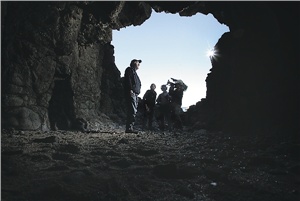
Sylvia Liber/Illawara Mercury
The documentary, Ancient Mega-Tsunamis, is based on the theories of University of Wollongong associate professor Ted Bryant and the Holocene Impact Working Group, a collective of scientists from the United States, Russia, France, Ireland and Australia.
‘Ted Bryant believes the meteor impact 500 years ago created mega-tsunamis that devastated coastal populations along the NSW coast as well as parts of New Zealand’, the show’s associate producer, Jackie Forster, said.”
[Full Story]
“499 priests to ward off storm surge”
August 22, 2008, Bangkok Post, Thailand
“A total of 499 Buddhist, Christian, Islamic and Hindu priests and a Buddha statue in the ‘Calming the Ocean’ posture will take part in a ritual next Tuesday to keep the province’s coastline safe from storm surges.
Provincial governor Anuwat Maytheewibulwut said the ‘Stop the wind, stop the water’ ceremony will be held at the provincial hall in Muang district.
The ancient Buddha statue will be borrowed from Wat Phra Samut Chedi, and its presence will be the highlight of the ceremony.
The statue is in a standing position with forearms raised, palms forward.
It portrays an episode when Lord Buddha saved worshippers from a flood in Magadha state of India.”
[Full Story]
“Tsunami or melting glaciers:
What caused ancient Atlit to sink?”
June 04, 2008, Ha’aretz, Israel
“At the bottom of the sea, some 300 meters west of the Atlit fortress, lies one of the greatest archaeological mysteries of the Mediterranean basin. About 20 years ago, archaeologists discovered a complex of ancient buildings and ancient graves with dozens of skeletons at the underwater site of Atlit-Yam.
The team of marine archaeologists that excavated the site, headed by Dr. Ehud Galili of the Israel Antiquities Authority, came to the consclusion that an ancient settlement once existed there, but sank beneath the surface of the sea some 8,000 years ago.
The finds at the site, including goat and pig bones and wheat seeds, indicate that it was a well-established community whose residents supported themselves by agriculture, hunting, fishing and animal husbandry.
Over the past few months, a major argument has erupted among researchers over what caused the village and the surrounding region to flood.
A few months ago, a team of geologists from Pisa, Italy published a paper that offers a dramatic theory about how the ancient settlement met its end. They claim that the settlement was submerged all at once by a tsunami in the Mediterranean, causing the death of dozens of its inhabitants. This theory attributes the tsunami to something that happened thousands of kilometers away.
About 8,300 years ago, there was a mighty volcanic explosion at Mt. Etna in Sicily. The Italian geologists examined the area of the volcano, which is still active today, and found that the explosion caused a tremendous avalanche of rocks to go tumbling into the sea.
They came to the conclusion that this event gave rise to a giant tsunami that crossed the Mediterranean, reached its eastern shore and, among other things, caused the destruction of Atlit-Yam and the death of its residents.”
[Full Story]
“Forecasting Tsunami Threats Through Layers
of Sand and Time”
March 18, 2008, NewsWise, USA:
“‘Azhii peralai: from the deep … large waves.’. This is the expression for ‘tsunami’ in Tamil, the oldest language in southern India.
For an ancient dialect to have its own phrase for destructive waves triggered by earthquakes, the people of Tamil Nadu likely experienced tsunamis periodically through the centuries, says Halifax scientist Alan Ruffman.
In other words, the catastrophic Indian Ocean event in December 2004 that killed 230,000 people in a dozen countries – including 15,000 in India – was hardly a one freak occurrence, he says, and people could have been much better prepared for it.
The proof lies in the layers below the Earth’s surface, says Mr. Ruffman, honorary research associate in Dalhousie’s Department of Earth Sciences. What better way to predict the threat of future tsunamis than studying patterns from the past?
Coastal sediments provide a potent geological record of recent and ancient tsunamis, he says, adding that the size of the sand particles can provide clues about the actual height of the water column.
He points to a compelling photo of a research colleague at a dig in Thailand, showing four distinct bands of sand. The surface layer was deposited by the 2004 tsunami, and Mr. Ruffman figures the next layer was left by an event dating back 400 to 600 years. ‘The tsunami that laid that one down was probably about the same size as the one in 2004’, he says.”
[Full Story]
“Tsunami that devastated the ancient world could return”
March 09, 2008, Arab Times, Kuwait:
“‘The sea was driven back, and its waters flowed away to such an extent that the deep sea bed was laid bare and many kinds of sea creatures could be seen’, wrote Roman historian Ammianus Marcellus, awed at a tsunami that struck the then-thriving port of Alexandria in 365 AD.
‘Huge masses of water flowed back when least expected, and now overwhelmed and killed many thousands of people… Some great ships were hurled by the fury of the waves onto the rooftops, and others were thrown up to two miles from the shore.’
Ancient documents show the great waves of July 21, 365 AD claimed lives from Greece, Sicily and Alexandria in Egypt to modern-day Dubrovnik in the Adriatic. Swamped by sea water, rich Nile delta farmland was abandoned and hilltop towns became ghost-like, inhabited only by hermits.
The tsunami was generated by a massive quake that occurred under the western tip of the Greek island of Crete, experts believe.
Until now, the main thinking has been that this quake — as in the Indian Ocean tsunami of December 26, 2004 — occurred in a so-called subduction zone. A subduction zone is where two of the Earth’s plates meet. One plate rides over another plate which is gliding downward at an angle into the planet’s mantle.
The 365 AD quake occurred at a point on the 500-kilometre (300-mile) -long Hellenic subduction zone, which snakes along the Mediterranean floor in a semi-circle from southwestern Turkey to western Greece.”
[Full Story]
“Archaeologists reject theory about mega-tsunamis hitting Australia 10,000 years back”
February 04, 2008, Daily India, USA:
“Archaeologists have rebuffed a theory by geological researchers that Australia has been subject to prehistoric mega-tsunamis up to 20 m in height over the past 10,000 years.
According to a report in The Australian, in 2003, geological researchers suggested that ancient tsunamis over the past 10,000 years were much larger than those recorded since European settlement.
This theory was based on findings of shell and coral deposits in a 2,500 km stretch of the WA (Western Australia) coast, supposedly caused due to tsunami surges up to 20m in height.
But now, archaeologists from the Australian National University (ANU) have rejected this theory, saying that deposits might be a result of Aboriginal occupation.”
[Full Story]
“Mega-tsunami theory disputed”
February 03, 2008, The Australian, Australia:
“SUPPOSED evidence Australia has been subject to prehistoric tsunamis up to 20m in height over the past 10,000 years could just be the result of Aboriginal occupation, a major conference is set to hear tomorrow.
Archaeologists from the Australian National University say the theory about the mega-tsunamis, which has influenced the development of emergency service plans in Western Australia, is not supported by evidence.
In 2003 Australian geological researchers suggested prehistoric tsunamis over the past 10,000 years were much larger than those recorded since European settlement, including findings of surges up to 20m in height affecting a 2500km stretch of the WA coast.
‘Our field work would suggest that the shell and coral deposits found high on headlands in WA or further inland are evidence of Aboriginal occupation of the area, and not deposits of mega-tsunamis or other major inundations’, ANU researcher Dr Tony Barham said.
He and colleagues Dr Sue O’Connor and Dr Stewart Fallon have also found that archaeological deposits in the area have not been disturbed by major inundation for 1000 years, undermining the theory that giant waves had flooded the area once every 400 to 500 years. The findings will be presented to the Archaeological Science Conference at ANU, which starts tomorrow and concludes Wednesday.”
[Full Story]
|
|
To understand why this News Page is sometimes late here is some information about Fibromyalgia
if you would like to support our marine archaeology research
The Morien Institute
Research Projects
please send us a book

from our Wish List
Ancient Mysteries
Bookshoppe
for a wide selection of
books that challenge
orthodox views of
prehistory on
our planet :
“Eden in the East: The Drowned Continent of Southeast Asia”
Stephen Oppenheimer

EU English Edition
“A book that completetly changes the established and conventional view of prehistory by relocating the Lost Eden – the world’s 1st civilization – to SouthEast Asia. At the end of the Ice Age, SouthEast Asia formed a continent twice the size of India, which included Indochina, Malaysia, Indonesia and Borneo.
The South China Sea, the Gulf of Thailand and the Java sea, which were all dry, formed the connecting parts of the continent. Geologically, this half sunken continent is the Shunda shelf or Sundaland.
He produces evidence from ethnography, archaeology, oceanography, from creation stories, myths and sagas and from linguistics and DNA analysis, to argue that this founder civilization was destroyed by a catastrophic flood, caused by a rapid rise in the sea level at the end of the last ice age.”
“Red, Earth, White Lies: Native Americans & the Myth of Scientific Fact”
Vine Deloria

EU English Edition
“Leading Native American scholar and author of the best-selling books God Is Red and Custer Died for Your Sins, Vine Deloria, Jr., addresses the conflict between mainstream scientific theory about the world and the ancestral worldview of Native Americans. Claiming that science has created a largely fictional scenario for American Indians in prehistoric North America, Deloria offers an alternative view of the continent’s history as seen through the eyes and memories of Native Americans.
“The World Almanac and Book of Facts”
Ken Park (Editor)

EU English Edition
extracts from pages
in the book:
“… systems can drive ocean water inland and cause significant flooding. Coastal floods can also be produced by sea waves called tsunamis, sometimes referred to as tidal waves: these waves are produced by earthquakes or volcanic activity
“… of the volcano collapsed to 1,000 ft below sea level, sinking most of the island and killing over 3,000. A tsunami (tidal wave) generated by the collapse killed more than 31,000 people in Java and Sumatra, and eventually reached England.”
“Furious Earth: The Science and Nature of Earthquakes, Volcanoes, and Tsunamis”
Ellen J. Prager
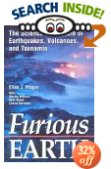
EU English Edition
from the back cover:
“The Science Behind the Earth’s Most Catastrophic Phenomena. If our planet is a sleeping giant, it slumbers fitfully and awakens in powerful starts. Our familiar landscape bears the scars f hidden forces at work deep beneath it. Furious Earth contains the latest science on these forces and the cataclysmic phenomena they produce – earthquakes, volcanoes, and tsunamis.
Now, hard-won knowledge of these phenomena, gained often in the aftermath of disaster or through dangerous research efforts, is presented here by scientist Ellen Prager with the following experts: Stanley Willaims, Ph.D. Professor of Volcanology, Arizona State University, on volcanoes; Kate Hutton, Ph.D., Seismologist, California State Institute of Technology, on earthquakes; Costas Synolakis, Ph.D., Professor of Civil Engineering, University of Southern California, on tsunamis.”
Japan’s Mysterious Pyramids: YONAGUNI

Do undersea relics near Okinawa offer proof of a sophisticated civilization during the last ice age?
www.historychannel.com
A Further Selection Of Books About:
Tsunami
Tidal Waves
Earthquakes
Volcanoes
|